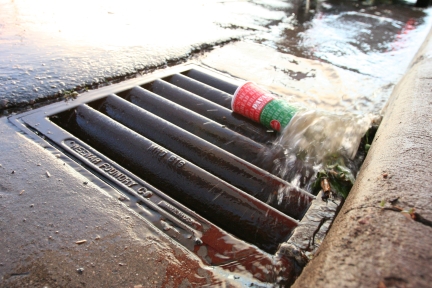
Municipal stormwater
Rain and melting snow create runoff as they move across the landscape to lakes, streams, rivers, and wetlands. In urban areas, most stormwater falls on streets, sidewalks, parking lots, roofs, and other hard surfaces and carries pesticides, fertilizers, oils, metals, salt, bacteria, litter, yard waste, sediment, and other materials down storm drains and into lakes and streams. Unlike wastewater, most stormwater is not treated before it empties into nearby bodies of water. Not surprisingly, stormwater runoff is a leading source of water pollution.
In addition to the contaminants it carries, stormwater runoff from hard, urban surfaces travels faster and in large quantities, the force of which damages rivers, streams and wetlands and can destroy habitats for fish and other aquatic life. Impervious surfaces also prevent stormwater from filtering into the ground and recharging groundwater.
A public entity's stormwater system (ditches, stormwater ponds, curbs and gutters, storm drains, catch basins, storm sewer pipes, and so on) is called a municipal separate storm sewer system (MS4). This does not include systems where wastewater and stormwater are combined. The MPCA regulates MS4 systems as mandated by the federal Clean Water Act with the goal of improving water quality by reducing pollutants in stormwater discharges. MS4 regulations require that owners/operators educate citizens on stormwater management issues and include them in solving stormwater problems, make plans to detect and stop illicit discharges, control runoff on construction sites, and more.
Learn more: Municipal stormwater
Current challenges in municipal stormwater
In most towns and cities, there's a storm drain on almost every street corner. That's a lot of openings to the storm sewer—a direct path to lakes and streams. So keeping contaminants out of stormwater requires effort from everybody: keeping leaves and grass clippings away from curbs, using phosphorus-free lawn fertilizer, picking up litter when you see it, and directing your rain gutters onto your lawn or into a rain barrel. Some of the larger challenges include:
Chloride (salt). The salt applied to roads, parking lots, and sidewalks during our icy winters contains chloride, a water pollutant. When snow and ice melts, the salt goes with it, washing into storm drains and then lakes and rivers. It takes only one teaspoon of road salt to permanently pollute five gallons of water. Once in the water, there is no way to remove the chloride, and at high concentrations, chloride can harm fish and plant life.
Lawn care practices. Homeowners use up to 10 times more chemical pesticides per acre on their yards than farmers use on their crops, according to the U.S. Fish and Wildlife Service. A lot of that fertilizer will end up in stormwater. Unraked leaves get into the gutter. Patios and driveways add to the hard surfaces over which stormwater runs, rather than soaking into the ground.
Industrial stormwater
Facilities in specific industries, that store materials, waste, or equipment outdoors, are subject to industrial stormwater regulations administered by the MPCA. These facilities must take steps to monitor and manage stormwater on their properties where stormwater may come into contact with harmful pollutants including toxic metals, oil, grease, de-icing salts, and other chemicals. Industries subject to stormwater regulation include:
- Lumber and wood companies, paper mills, chemical and petroleum businesses, concrete companies, foundries, and other metals operations
- Hazardous waste treatment, storage, or disposal facilities
- Landfills that receive industrial waste
- Recyclers and salvage yards
- Steam electric power generating facilities
- Facilities for vehicle maintenance, equipment cleaning, and airport deicing operations
- Sewage treatment works
- Light manufacturing facilities
Learn more: Industrial stormwater
Construction stormwater
When stormwater drains off a construction site, it carries sediment and other pollutants that can harm lakes, streams, and wetlands. The U.S. Environmental Protection Agency estimates that 20 to 150 tons of soil per acre are lost every year to stormwater runoff from construction sites.
To protect Minnesota waters, the MPCA issues permits to construction site owners and operators to prevent stormwater pollution during and after construction. As part of the permit application, site owners/operators must create a stormwater pollution prevention plan that explains how they will control stormwater. The agency oversees an average of more than 2,000 construction sites each year.
Learn more: Construction stormwater
Current challenges in construction stormwater
Given the thousands of construction sites operating around the state at any time, it's a challenge to stay on top of violations. The top five construction stormwater permit violations:
Missing or inadequate soil stabilization. Mats, mulches, blankets, and other strategies keep disturbed soils in place during construction.
Missing silt fence or other perimeter controls. Perimeter controls such as silt fence and biorolls prevent runoff and allow water through while sediment settles out.
Missing or inadequate inlet protection. Inlet protection captures sediment before it enters storm sewers.
Vehicle tracking. Vehicles driving off the site can track sediment onto paved surfaces. Rock pads and similar practices knock dirt off tires before it can be carried off the construction site.
Stormwater protection practices not maintained. For instance, it's not enough to just install a silt fence. It must be checked to ensure it hasn't been breached or knocked down.
Examples: